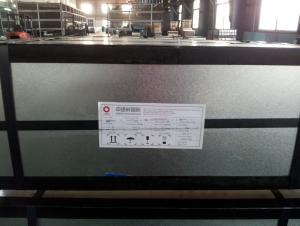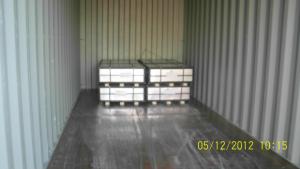Tin Free Steel
- Loading Port:
- China Main Port
- Payment Terms:
- TT OR LC
- Min Order Qty:
- -
- Supply Capability:
- -
OKorder Service Pledge
OKorder Financial Service
You Might Also Like
Tin Free Steel (TFS)
Is also known as chromed steel, as it is obtained by coating the metal base (low-carbon steel) with an ultra-thin layer of metallic chrome and then with a chromium oxide layer.This steel product was developed to meet economic requirements, and excels tinplate in paintability, paint adhesion, and economy. It is widely used for making beverage cans and 18-liter cans. It is also used for making photographic film cases and as a protective material for optical fiber cables.
Our TFS Specification:
Standard: AISI, ASTM, BS, DIN, GB, JIS
Material: MR,SPCC
Thickness:0.15mm - 0.45mm
Width: 600mm -1150mm
Temper: T1-T5
Annealing: BA & CA
- Q:How long does tinplate last?
- Tinplate can last for several decades or even longer with proper care and maintenance.
- Q:How is tinplate coated with organic coatings?
- Tinplate is coated with organic coatings through a process called electrolytic deposition. This involves immersing the tinplate in an electrolyte solution and passing an electric current through it. The organic coating materials, typically polymers or resins, are dissolved in the electrolyte solution and are attracted to the charged surface of the tinplate. As the electric current passes through, the organic coating materials are deposited onto the tinplate, forming a protective layer.
- Q:How does tinplate contribute to the protection of textile products?
- Tinplate contributes to the protection of textile products by providing a durable and corrosion-resistant packaging material. It acts as a barrier against moisture, oxygen, and other environmental factors that could damage the textiles. Additionally, tinplate containers can be sealed tightly, ensuring that the textile products remain intact and free from contamination during storage and transportation.
- Q:What are the main growth opportunities for the tinplate industry?
- The main growth opportunities for the tinplate industry include the increasing demand for packaged food and beverages, the rising popularity of sustainable packaging solutions, and the growing automotive sector requiring tinplate for various applications. Additionally, emerging markets and technological advancements in tinplate production processes offer significant growth potential for the industry.
- Q:What material is the tin plate, please?
- Tinplate is a tin covered with tin, it is not easy to rust, also known as tin iron
- Q:How does tinplate affect the cost of packaging?
- Tinplate can affect the cost of packaging by increasing it due to the higher price of tin compared to other materials. However, it also offers several advantages such as durability, extended shelf life, and enhanced product protection, which can justify the higher cost for certain applications.
- Q:How does tinplate handle extreme weather conditions?
- Tinplate is known for its excellent resistance to extreme weather conditions. It is highly durable and can withstand harsh temperatures, humidity, and exposure to sunlight without significant degradation. Its protective coating prevents rusting and corrosion, making it a reliable choice for outdoor applications.
- Q:Why tin printing after a layer of light oil
- Bright oil is common in epoxy resin, alkyd resin, acrylic resin, acrylic amino, etc., the composition is different, the performance is also different, and the use is not the same. Usually according to the process whether there is a deep stamping deformation, welding local high temperature heating and the need for high pressure cooking and so on, choose different types of varnish.In order to increase production efficiency and save energy, in general, the last printing process is combined with the glazing process.In addition to the roller coating can be used, but also can be printed light ink method, both gloss is not much difference, but the processing performance is better than roller coating.
- Q:How does tinplate perform in terms of tamper-evident features?
- Tinplate performs exceptionally well in terms of tamper-evident features. Its inherent strength and durability make it difficult to tamper with or manipulate without leaving clear signs of tampering. Additionally, tinplate can be customized with various tamper-evident mechanisms such as seals, closures, or indicators, further enhancing its reliability as a tamper-evident packaging material.
- Q:How does tinplate contribute to the shelf life of canned products?
- Tinplate contributes to the shelf life of canned products by providing a protective barrier that prevents contact between the food and the metal of the can. This barrier helps to minimize the risk of corrosion and preserves the quality, flavor, and nutritional value of the canned product for an extended period of time.
1. Manufacturer Overview |
|
|---|---|
| Location | |
| Year Established | |
| Annual Output Value | |
| Main Markets | |
| Company Certifications | |
2. Manufacturer Certificates |
|
|---|---|
| a) Certification Name | |
| Range | |
| Reference | |
| Validity Period | |
3. Manufacturer Capability |
|
|---|---|
| a)Trade Capacity | |
| Nearest Port | |
| Export Percentage | |
| No.of Employees in Trade Department | |
| Language Spoken: | |
| b)Factory Information | |
| Factory Size: | |
| No. of Production Lines | |
| Contract Manufacturing | |
| Product Price Range | |
Send your message to us
Tin Free Steel
- Loading Port:
- China Main Port
- Payment Terms:
- TT OR LC
- Min Order Qty:
- -
- Supply Capability:
- -
OKorder Service Pledge
OKorder Financial Service
Similar products
New products
Hot products
Related keywords




























